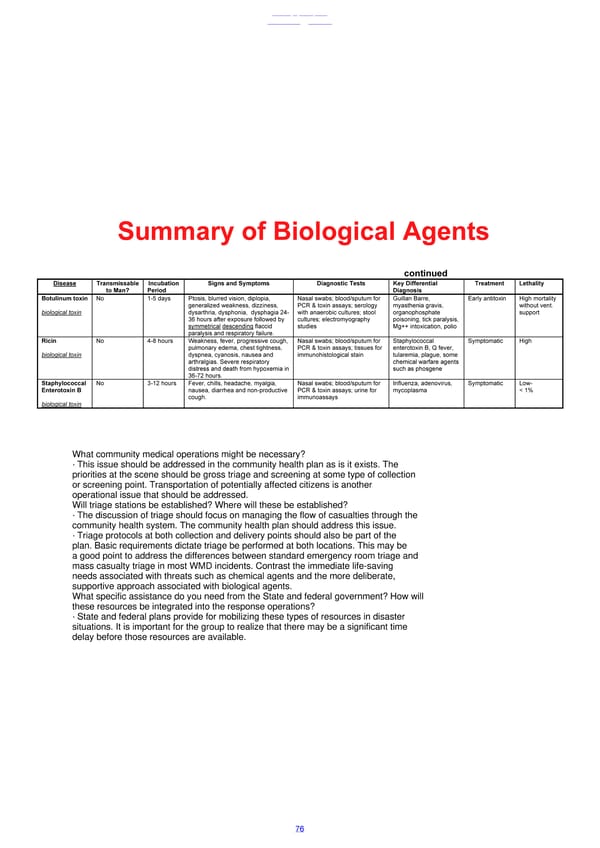Summary of Biological Agents continued Disease TransIncubation mSigns aissable nd Symptoms Diagnostic Tests Key Differential Treatment Lethality to Man? Period Diagnosis Botulinum toxin No 1-5 days Ptosis, blurred vision, diplopia, Nasal swabs; blood/sputum for Guillan Barre, Early antitoxin High mortality generalized weakness, dizziness, PCR & toxin assays; serology myasthenia gravis, without vent. biological toxin dysarthria, dysphonia, dysphagia 24- with anaerobic cultures; stool organophosphate support 36 hours after exposure followed by cultures; electromyography poisoning, tick paralysis, symmetrical descending flaccid studies Mg++ intoxication, polio paralysis and respiratory failure. Ricin No 4-8 hours Weakness, fever, progressive cough, Nasal swabs; blood/sputum for Staphylococcal Symptomatic High pulmonary edema, chest tightness, PCR & toxin assays; tissues for enterotoxin B, Q fever, biological toxin dyspnea, cyanosis, nausea and immunohistological stain tularemia, plague, some arthralgias. Severe respiratory chemical warfare agents distress and death from hypoxemia in such as phosgene 36-72 hours. Staphylococcal No 3-12 hours Fever, chills, headache, myalgia, Nasal swabs; blood/sputum for Influenza, adenovirus, Symptomatic Low- Enterotoxin B nausea, diarrhea and non-productive PCR & toxin assays; urine for mycoplasma < 1% cough. immunoassays biological toxin What community medical operations might be necessary? · This issue should be addressed in the community health plan as is it exists. The priorities at the scene should be gross triage and screening at some type of collection or screening point. Transportation of potentially affected citizens is another operational issue that should be addressed. Will triage stations be established? Where will these be established? · The discussion of triage should focus on managing the flow of casualties through the community health system. The community health plan should address this issue. · Triage protocols at both collection and delivery points should also be part of the plan. Basic requirements dictate triage be performed at both locations. This may be a good point to address the differences between standard emergency room triage and mass casualty triage in most WMD incidents. Contrast the immediate life-saving needs associated with threats such as chemical agents and the more deliberate, supportive approach associated with biological agents. What specific assistance do you need from the State and federal government? How will these resources be integrated into the response operations? · State and federal plans provide for mobilizing these types of resources in disaster situations. It is important for the group to realize that there may be a significant time delay before those resources are available. 76
 Military English. Learning by Doing. Book Page 15 Page 17
Military English. Learning by Doing. Book Page 15 Page 17